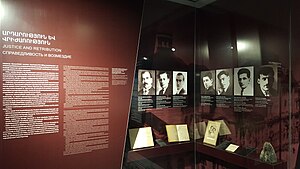Operation Nemesis
| Operation Nemesis | |
|---|---|

An exhibition dedicated to Operation Nemesis at the genocide museum in Yerevan, Armenia
|
|
| Location | Berlin, Tiflis, Constantinople, Rome |
| Date | 1920–1922 |
| Target | Ottoman officials responsible for the Armenian Genocide, Azerbaijani officials responsible for the 1918 massacre of Armenians in Baku |
|
Attack type
|
assassinations |
| Perpetrators | Armenian Revolutionary Federation |
| Motive | Vigilante justice and revenge |
Operation Nemesis (Armenian: «Նեմեսիս» գործողութիւն Nemesis gortsoghut'iun) was a covert operation and an assassination campaign by the Armenian Revolutionary Federation (Dashnaktsutyun) carried out between 1920 and 1922, during which a number of former Ottoman political and military figures were assassinated for their role in the Armenian Genocide, as well as Azerbaijani figures for the 1918 massacre of Armenians in Baku. Shahan Natalie and Armen Garo are considered its masterminds. It was named after the Greek goddess of divine retribution, Nemesis.
The Armenian Revolutionary Federation (ARF) was active within the Ottoman Empire in the early 1890s with the aim of unifying the various small groups in the empire who advocated for reform and a certain degree of autonomy within the empire. ARF members formed fedayi guerrilla groups that helped organize self-defense of Armenian civilians. In July–August 1914, the 8th congress of the ARF was a watershed event. Members of the Committee of Union and Progress requested from the party assistance in the conquest of Transcaucasia by inciting a rebellion of Russian Armenians against the Russian army in the event of a Caucasus Campaign opening up. The Armenians agreed to remain loyal to their government, but declared their inability to agree to the other proposal.
Prominent ARF members were among the Armenian intellectuals targeted on April 24, 1915 in Constantinople. The arrested people were moved to two holding centers near Ankara under Interior Minister Mehmed Talat's , and mostly deported and killed.
...
Wikipedia
